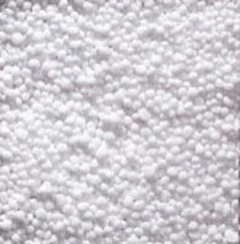Fertilisers
| Infobox on Fertilisers | |
|---|---|
| Example of Fertilisers |  |
| Facts | |
| Origin | 1.15 m3/t (without nitrate; bulk) |
| Stowage factor (in m3/t) | |
| Humidity / moisture | |
| Ventilation | |
| Risk factors | |
Fertilisers
Contents
Description
Fertilizer (or fertiliser) is any organic or inorganic material of natural or synthetic origin (other than liming materials) that is added to a soil to supply one or more plant nutrients essential to the growth of plants. Conservative estimates report 30 to 50% of crop yields are attributed to natural or synthetic commercial fertilizer.
Mined inorganic fertilizers have been used for many centuries, whereas chemically synthesized inorganic fertilizers were only widely developed during the industrial revolution.
Inorganic fertilizer use has also significantly supported global population growth — it has been estimated that almost half the people on the Earth are currently fed as a result of synthetic nitrogen fertilizer use.
Mined inorganic fertilizers typically provide, in varying proportions:
- six macronutrients: nitrogen (N), phosphorus (P), potassium (K), calcium (Ca), magnesium (Mg), and sulfur (S);
- eight micronutrients: boron (B), chlorine (Cl), copper (Cu), iron (Fe), manganese (Mn), molybdenum (Mo), zinc (Zn) and nickel (Ni) (1987).
The macronutrients are consumed in larger quantities and are present in plant tissue in quantities from 0.15% to 6.0% on a dry matter (0% moisture) basis (DM). Micronutrients are consumed in smaller quantities and are present in plant tissue on the order of parts per million (ppm), ranging from 0.15 to 400 ppm DM, or less than 0.04% DM.
Only three other macronutrients are required by all plants: carbon, hydrogen, and oxygen. These nutrients are supplied by water and carbon dioxide.
Forms
Fertilizers come in various forms. The most typical form is solid fertilizer in granulated or powdered forms. The next most common form is liquid fertilizer; some advantages of liquid fertilizer are its immediate effect and wide coverage.
There are also slow-release fertilizers (various forms including fertilizer spikes, tabs, etc.) which reduce the problem of "burning" the plants due to excess nitrogen. Polymer coating of fertilizer ingredients gives tablets and spikes a 'true time-release' or 'staged nutrient release' (SNR) of fertilizer nutrients.
More recently, organic fertilizer is on the rise as people are resorting to environmental friendly (or 'green') products. Although organic fertilizers usually contain a lower concentration of nutrients, this lower concentration avoids complication of nitrogen burn harming the plants. In addition, organic fertilizers such as compost and worm castings break down slowly into complex organic structures (humus) which build the soil's structure and moisture- and nutrient-retaining capabilities.
Inorganic commercial fertilizer Fertilizers are broadly divided into organic fertilizers (composed of organic plant or animal matter), or inorganic or commercial fertilizers. Plants can only absorb their required nutrients if they are present in easily dissolved chemical compounds. Both organic and inorganic fertilizers provide the same needed chemical compounds. Organic fertilizers provided other macro and micro plant nutrients and are released as the organic matter decays—this may take months or years. Organic fertilizers nearly always have much lower concentrations of plant nutrients and have the usual problems of economical collection, treatment, transportation and distribution.
Inorganic fertilizers nearly always are readily dissolved and unless added have few other macro and micro plant nutrients. Nearly all nitrogen that plants use is in the form of NH3 or NO3 compounds. The usable phosphorus compounds are usually in the form of phosphoric acid (H3PO4) and the potassium (K) is typically in the form of potassium chloride (KCl). In organic fertilizers nitrogen, phosphorus and potassium compounds are released from the complex organic compounds as the animal or plant matter decays. In commercial fertilizers the same required compounds are available in easily dissolved compounds that require no decay—they can be used almost immediately after water is applied. Inorganic fertilizers are usually much more concentrated with up to 64% (18-46-0) of their weight being a given plant nutrient, compared to organic fertilizers that only provide 0.4% or less of their weight as a given plant nutrient.
Synthetic fertilizers are commonly used for growing all crops, with application rates depending on the soil fertility, usually as measured by a soil test and according to the particular crop. Legumes, for example, fix nitrogen from the atmosphere and generally do not require nitrogen fertilizer.
Studies have shown that application of nitrogen fertilizer on off-season cover crops can increase the biomass (and subsequent green manure value) of these crops, while having a beneficial effect on soil nitrogen levels for the main crop planted during the summer season.
Nutrients in soil can be thrown out of balance with high concentrations of fertilizers. The interconnectedness and complexity of this soil ‘food web’ means any appraisal of soil function must necessarily take into account interactions with the living communities that exist within the soil. Stability of the system is reduced by the use of nitrogen-containing fertilizers, which cause soil acidification.
Applying excessive amounts of fertilizer has negative environmental effects, and wastes the growers' time and money. To avoid over-application, the nutrient status of crops should be assessed. Nutrient deficiency can be detected by visually assessing the physical symptoms of the crop. Nitrogen deficiency, for example has a distinctive presentation in some species. However, quantitative tests are more reliable for detecting nutrient deficiency before it has significantly affected the crop. Both soil tests and Plant Tissue Tests are used in agriculture to fine-tune nutrient management to the crops needs.











